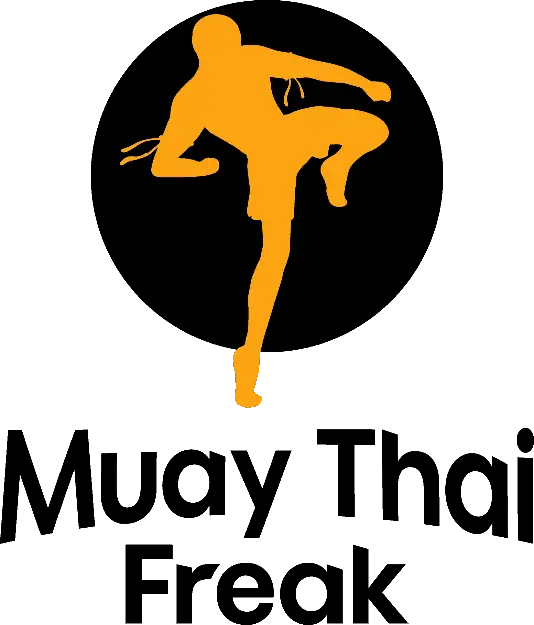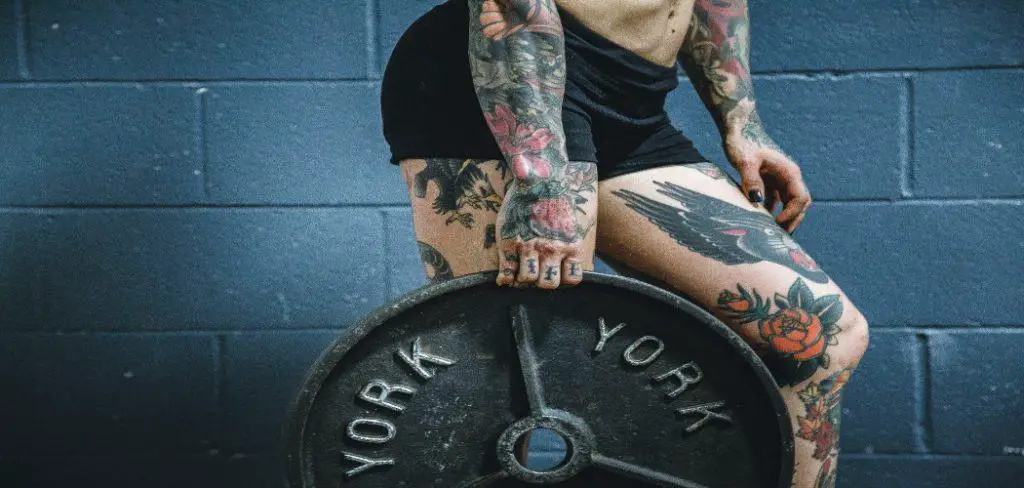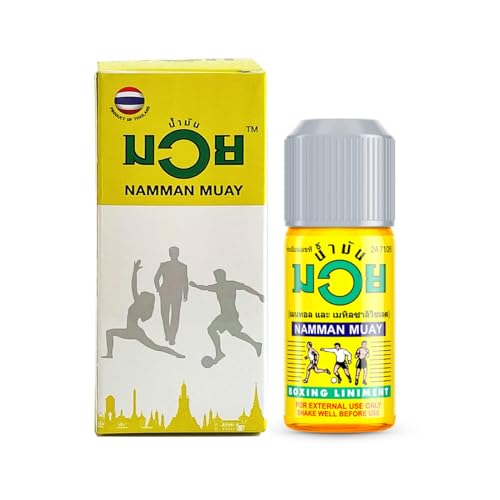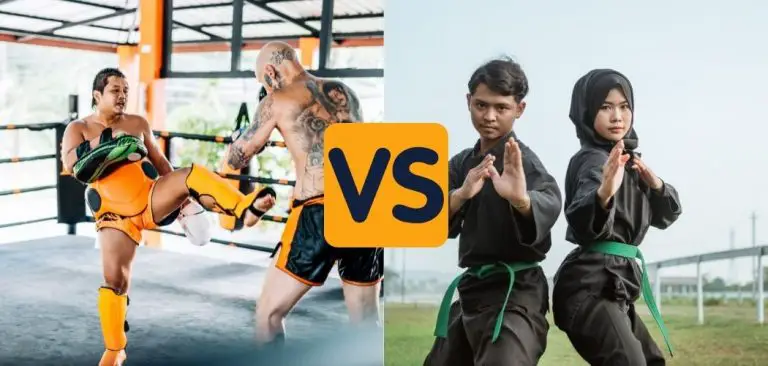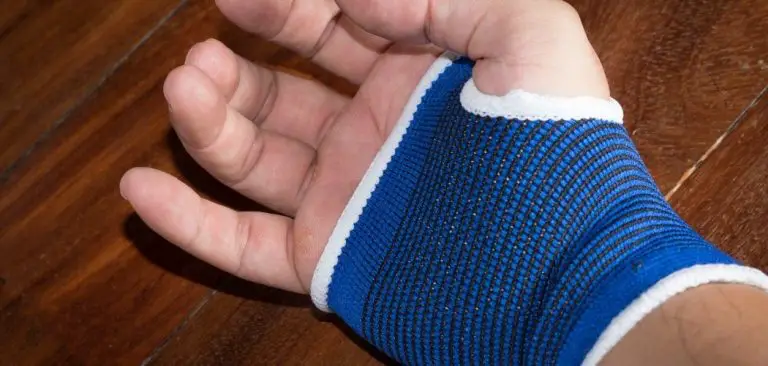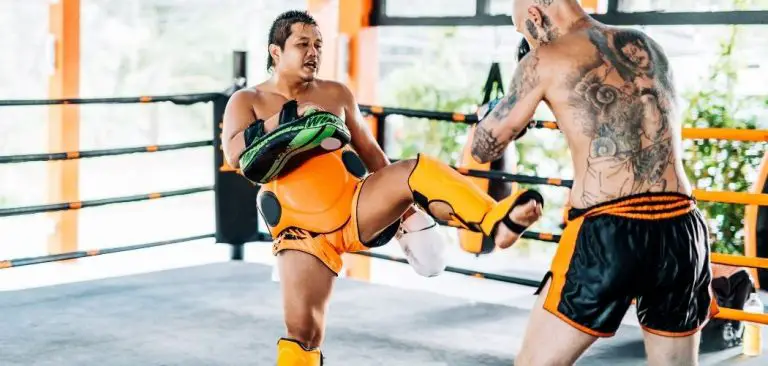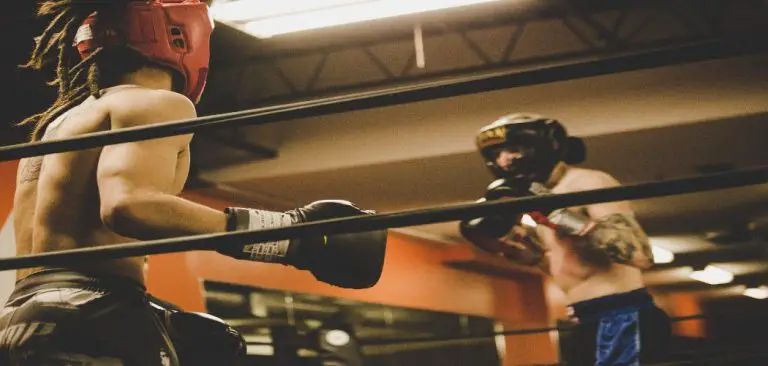Weight training sessions are still new in the world of Muay Thai. Heavier guys mostly tend to finish the fight via knockout, while smaller weight classes are known for quick strikes and amazing quickness.
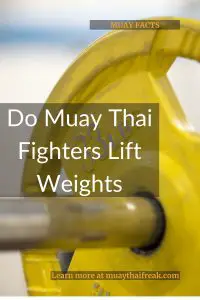
Many believe weight training sessions are a pure stupidity in the world of Thai boxing, but it is wrong. Muay Thai fighters lift weights, especially the ones who plan to become champions and division kings. I will break the controversy and guide you through the world of Muay Thai strikes and weight training.
Oh, a Muay Thai fighter who lifts weights doesn’t have to be strong like Hulk. Weight training sessions might affect your movement, quickness, explosiveness, posture, strike power, strike absorption, strike accuracy… I could discuss this all day long. But I will go straight to the point – there are differences between weight classes and fighting styles, but the same muscle groups are important for a high-quality Thai boxing performance. Oh yes, great Muay Thai fighters lift weights. Read on to see why!
Table of Contents
The Difference Between Weight Classes
It is impossible to create a unique set of rules here. But I am making a comparison between, for example, flyweight and middleweight division.
The basic rule says–lighter fighters are quicker and they move better, while heavier guys should rely on strong strikes and knockout power. But if you’re heavyweight, that doesn’t mean you’re a KO artist. Muay Thai fighters lift weights to turn into a one-punch knockout specialist, that’s true. But there are numerous other reasons, too.
Ring warriors in lower weight classes tend to focus on strength and endurance, while hypertrophy and power training sessions are pretty much neglected. You wonder why? Well, let me tell you – it increases your weight, which means you’ll have a hard time cutting it later. When someone wants to transition one division up or plans to fight in the heavyweight division, training sessions focus on hypertrophy, power, and strength.
Muay Thai fighters lift weights because the sport has changed a lot. Even very tall and heavy guys must work on their explosiveness and movement, especially if they want to win the belt.
Did I confuse you? Ok, please read on to resolve the dilemma.
The Difference Between Fighting Styles
In Muay Thai, many fighters go forward and trade bombs. I am aware that many readers will say that Thai boxing has only one fighting style, but that is wrong.

Muay Thai fighters lift weights less or more, depending on their fighting style. A counter-expert should be stronger than a brawler or a clinch expert, don’t you think so?
Years of training are required to build your fighting style, but you must understand the first part of this sentence in the first place. Please read carefully, because otherwise, you will never understand why Muay Thai fighters lift weights. Hey, guys, it’s not rocket science, here are a few most often fighting styles:
- Brawler – he/she goes forward and attacks his/her foe with a punch and kick combos. The fighter trades bombs and takes part in violent toe-to-toe exchanges. A knockout happens from time to time.
- Tactical expert – he thinks like a detective, exploits your vulnerabilities, and uses your weak spots against you. This opponent is very patient and he waits for your mistake. Counterpunch or counter kick knockouts might happen from time to time.
- Counter shot expert – These guys like to feint and use jabs to their advantage. Confusing the opponent is a very important part of their game. If you start running forward and landing haymakers, they’ll probably duck or clinch up and punish you with a brutal counterstrike (knee, kick, punch or elbow).
- One-punch KO fighter – it is rare in Muay Thai, but this type of fighter is usually very predictable. They are masters of one or two techniques, preferably punches. Muay Thai fighters lift weights especially because of “heavy hands”. Sometimes it’s easier to stop the opponent with one powerful shot than fighting for 9 or 15 minutes.
- Point collector – the fighter who collects more points usually wins in smaller divisions as many ring warriors are not strong enough for a knockout blow. These guys will usually try to outlast or outwork you. They are famous for speed and movement.
- Clinch experts – knees to the head, sweeps, low kicks, rabbit punches, and knees… Muay Thai rules are very liberal when it comes to clinching, so these types of opponents are very dangerous, especially if you’re a long-range kicking or punching experts.
Most Important Muscle Groups
Good Muay Thai performance demands a powerful and strong upper back, midsection, groins, and arms. Legs are important too, but putting legs to the fore might be a mistake.
Muay Thai is “The Science of Eight Limbs”. So let me show you the most important muscle groups for the ancient Siamese martial art:
- Upper back (Trapezoids),
- Shoulders (Deltoid muscles)
- Triceps,
- Chest (Pectoral muscles),
- Biceps (mostly during uppercuts),
- Groins,
- Glutes and lower back,
- Quadriceps,
- Calves.
Oh, yeah, the order matters! Keep reading to understand the basic mechanics of Muay Thai. Better late than never, isn’t it?
The upper back is mostly active during covering up and keeping your hands up, especially when you’re pressed against the ropes. It is also very active when you land straight punches (jabs, crosses) and hooks (when you return the punch to the guard).
Your deltoid muscles are active all the time. It doesn’t matter whether you cover up or attack the opponent with a punch flurry, every single part of your shoulders will be put on fire.
Jabs, crosses, and weaving overhands activate triceps. If you’re a taller guy who chases the smaller fighter, then you know what I’m talking about. The lateral part of your arms is under siege.
Biceps can help you a lot when you land powerful uppercuts or uppercut elbows off the clinch. If you watched the UFC Fight Night 52 fight between Mark “The Super Samoan” Hunt and Roy Nelson, then you saw how Mark’s bicep played a critical role in turning the lights out on Nelson.
Each punch puts your pectoral muscles on fire, especially when it comes to one-punch knockout artists. Different areas of your chest are activated during different punches and elbows.
If you’re a kicking machine, then you need very powerful quads. Muay Thai fighters lift weights for a strong lower part of the body, mostly to improve the power of front kicks, teep kicks, oblique kicks, and high kicks.
Adductors are so important for powerful knees off the clinch and high kicks. Many people will laugh their asses off when you say that, but you’ll knock them out and they’ll change their mind.
Quads don’t work much if you spin (spinning back and hook kick plus tornado kick), but then lower back and glutes come to the fore.
Calf muscles will work when you check kicks, but they’ll be active during your flying knees and jumping kicks too. So don’t neglect this part of your body, please!
Important Weight Lifting Exercises For Muay Thai Fighters
I’ll be honest, every single exercise is kinda important, but you must understand why and how Muay Thai fighters lift weights. Can the barbell/dumbbell training sessions affect your performance and how?
Strength and conditioning exercises can be beneficial for you, and here is the list of the most important weight training beauties.
½ (Semi) Squat
This exercise is very important for all kinds of kicks and knees. It affects your quads, glutes, and lower back, and improves your spinning techniques too.
Stiff-Legged Deadlift
Regular deadlift strengthens primarily your back, but you’ll need stronger hamstrings for successful Muay Thai results. When you retreat, the rear side of your body is put on fire, so this is a super-important drill.
Jefferson Squat
Let me guess your question. What the heck? Well, this exercise strengthens glutes, quads, and adductors, but it locks your arms, which leads to better covering up and defending. You’ll keep your hands up in a battle!
Single-Leg Extensions
Push kicks, knees, teep kicks, plus jumping knees. Oh yeah, you’re ready to roll and push the pace and show some great long-range skills!
Bench Press
Bench press improves all kinds of punches and elbows except spinning backfist and spinning back elbow.
Standing Barbell Calf Raises
You’ll move explosively to the side, forward or backward because of this drill. It turns you into a movement phenom.
Lateral Raises
The lateral side of your deltoid muscles plays a vital role in blocking high kicks, hooks, overhands, and other circular techniques, especially against an aggressive opponent who pressures you all the time.
Narrow Grip Front Lat Machine Pulldowns
You’ll be able to defend more strikes, especially when you cover up and defend punch or elbow flurry. More power means better defensive abilities.
You can also check out my article on 7 Muay Thai strength training tips.
Muay Thai Fighters Lift Weights – Targeting Specific Features
Different training sessions will target different skillsets. To kick-off, please determine your one-repetition maximum (1 RM) value. That’s the maximum weight you can lift for a single repetition for a given exercise.
According to different authors, the results might vary, but this calculator might help.
Muay Thai fighters lift weights to fight better, and each feature boosts some aspects of your striking game. I will take a closer look at maximum strength, power, hypertrophy-oriented strength, and explosiveness and explain the details.
Note: I assume your weightlifting technique is good, if it’s bad, please hire a strength and conditioning coach.
Maximum Strength
It means a relatively low speed of action with big weights (90% 1 RM or above). Rest periods are enormous (3+ minutes), training volume is small, but it turns you into a knockout machine. Muay Thai fighters lift weights to hit harder!
Here is one example: Rest 3 minutes or more between the sets. Oh, please, you mustn’t do this if your fight happens in less than 72 hours!
Stiff-legged deadlift, 3-4 reps, 90% 1 RM, 4-5 sets, 3+ minutes rest between sets
Bench press, 3-4 reps, 90% 1 RM, 4-5 sets, 3+ minutes rest between sets
Narrow grip lat machine pull-downs, 3-4 reps, 90% 1 RM, 4-5 sets, 3+ minutes rest between sets
Leg extensions, 3-4 reps, 90% 1 RM, 4-5 sets, 3+ minutes rest between sets
Power
Powerful strikes are awesome, especially when you attack the opponent with a combo. It is also beneficial for counterstrikes. As well as you know, power (P) = F (force) x v (velocity). But more power means greater KO ability. Rest 90-120 seconds between the sets.
It is amazing for tactical experts, clinch fighters, or brawlers. But please don’t do it less than 7 days before your fight.
Stiff-legged deadlift, 6 reps, 83-85% 1 RM, 4 sets, 90-120 seconds rest between sets
Bench press, 6 reps, 83-85% 1 RM, 4 sets, 90-120 seconds rest between sets
Narrow grip lat machine pull-downs, 6 reps, 83-85% 1 RM, 4 sets, 90-120 seconds rest between sets
Leg extensions, 6 reps, 83-85% 1 RM, 4 sets, 90-120 seconds rest between sets
Hypertrophy-Oriented Strength
Sometimes you’ll have to get some muscles, especially if you intend to cruise a few pounds north and change weight class. You can do this if and only if your match is at least 28 days away.
It is also good for knockout artists or fighters in the offseason, a great way to add some strength to your body. But if you drop weight, please stay away from these kinds of training sessions.
Please perform 4-6 exercises, 75-120 seconds of rest between sets, 75-90 seconds rest between exercises.
Bench press, 8-12 reps, 70-75% 1RM, 3-5 sets, 75-120 seconds between sets
Stiff-legged deadlift, 8-12 reps, 70-75% 1RM, 3-5 sets, 75-120 seconds between sets
Alternate front dumbbell raises, 8-12 reps, 70-75% 1RM, 3-5 sets, 75-120 seconds between sets
Jefferson squats, 8-12 reps, 70-75% 1RM, 3-5 sets, 75-120 seconds between sets
Narrow grip front lat machine pull-downs, 8-12 reps, 70-75% 1RM, 3-5 sets, 75-120 seconds between sets
Standing barbell calf raises, 8-12 reps, 70-75% 1RM, 3-5 sets, 75-120 seconds between sets
Explosiveness
Muay Thai fighters lift weights to hit faster too. Oh, I know, this sounds like a fairy tale, right? Well, try it out and you’ll see major differences in your striking speed!
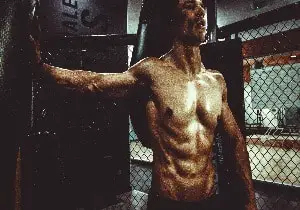
Explosiveness means as quickly as possible in a very small time frame. Great for point collectors, because explosive strikes bring a lot of points. But you can also fake with a quick strike and create an opening for a big powerful bomb (example, left jab followed by a big right hook or Superman punch). Bingo! Please warm-up properly or you might hurt yourself.
Do it with very light weights (30-50% or your 1 RM). Rest periods are 60-120 seconds, your body must recover, otherwise, your training session makes no sense. You must rest properly between the sets.
Oh, you can do this one day or even a few hours before the bout. Your results will rock, I’d bet my rent money on it! It is very beneficial for tacticians, counter strikers, and clinch fighters.
Bench press, 10-15 reps, 30-50% 1 RM, 3 sets, 60-120 seconds rest between sets
½ squat, 10-15 reps, 30-50% 1 RM, 3 sets, 60-120 seconds rest between sets
Alternate front dumbbell raises each arm, 10-15 reps, 30-50% 1 RM, 3 sets, 60-120 seconds rest between sets
Standing barbell calf raises, 10-15 reps, 30-50% 1 RM, 3 sets, 60-120 seconds rest between sets
Narrow grip front lat machine pull-downs, 10-15 reps, 30-50% 1 RM, 3 sets, 60-120 seconds rest between sets
Single-leg extensions, 10-15 reps each leg, 30-50% 1 RM, 3 sets, 60-120 seconds rest between sets
Conclusion
Weights should become an essential part of Muay Thai, especially for fighters who plan to win tournaments. Muay Thai fighters lift weights to improve strength and conditioning, but also to change the fighting style, increase the power of the strike, and to boost footwork/movement.
Many believe people lift weights to become big like Konan Barbarian. But that’s wrong, you should never believe them. In Muay Thai, weight lifting is the ultimate weapon that makes the difference between an average and a world-class fighter.
Last Updated on May 21, 2022 by Deni
